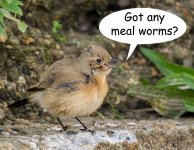Reader
Well-known member
Thanks James
Exactly my point but far more succintly put than my post.
John
Exactly my point but far more succintly put than my post.
John
This is playing Devil's Advocate -
I do think feeding garden birds is different to migrants. Take the example of the Steppe Grey Shrike, I think that it is quite likely that it would have moved on earlier without the supply of mealworms. Staying the extra few days as a result of the artifical source of food (note: the source of the food is artificial, not the food type) could mean that the weather is colder and less food is around at secondary stopping off points as it attempts to migrate. In this way the supplementary feeding has had a detrimental effect.
The secondary point is probably about manipulating a birds behaviour for personal ends, e.g. the vole post was put up by trespassing, and some people resented seeing the Desert Wheatear near a hand. I think that it is also possible that some birders feel that mealworms are being used as a proxy for fieldcraft or patience.
I am not strongly against feeding of migrant birds, my first Red-flanked Bluetail at Muckleburgh Hill was doing a circuit but returning to an area where mealworms had been laid, but it does raise some questions and I can see why it is a controversial topic.





